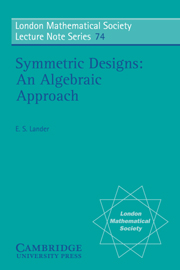CHAPTER 6 - OPEN QUESTIONS
Published online by Cambridge University Press: 16 March 2010
Summary
In this chapter we discuss some important open questions and conjectures concerning difference sets. Answering these questions apparently will require new and powerful techniques or clever counterexamples; perhaps the reader will try to wrestle with one or more of these questions.
Existence
The broadest open question is of course: For what
(v, k, λ) and abelian groups G, does there exist a (v, k, λ)– difference set in G? Despite many examples and many nonexistence theorems, there is no complete conjectured answer. A partial guess, related to Conjecture 2.4 is the following.
Conjecture 6.1.For each λ>1, there exists (up to isomorphism) only finitely many abelian (v, k, λ)– difference sets.
There is slightly more evidence amassed in favor of Conjecture 6.1 than Conjecture 2.4. Specifically, Dickey and Hughes [64] have shown that the only abelian (v, k, 2) – difference sets with k ≤ 5000 are the known ones with k=3, 4, 5, 6 or 9.
Table 6–1, at the end of this chapter, lists the state of my knowledge concerning abelian difference sets with k ≤ 50. There are 268 quadruples (v, k, λ, G) where G is an abelian group of order v and (v, k, λ) satisfy (v−l)λ= k(k−l), Schutzenberger's Theorem, the Bruck–Ryser–Chowla conditions and k≤v/2. Of these, 65 correspond to known difference sets, 178 are shown not to exist and 25 are undecided. I would be grateful to hear from readers who can complete any of the missing entries in the table.
Cyclic Sylow Subgroups
No one has yet discovered an example of a cyclic (v, k, λ)-difference set in which (v, n)≠1.
Information
- Type
- Chapter
- Information
- Symmetric DesignsAn Algebraic Approach, pp. 223 - 244Publisher: Cambridge University PressPrint publication year: 1983
